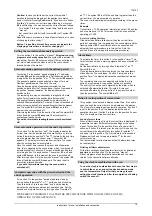
179732
Instructions for use, installation and connection
12
Cleaning and maintenance
Never clean the appliance with pressurized hot steam cleaner!
Before cleaning switch the cooker off and let it cool down
completely.
Front side of the casing
For cleaning of frontal part of the cooker use the usual cleaning
agents and follow the manufacturer's instructions.
Never use any aggressive cleaning agents or dish cleaning
accessories which might cause scratches.
Stainless steel front
(certain models only)
Clean the surface with mild detergent (soap) and soft sponge
which does not scratch. Never use aggressive cleaners or
solvents, otherwise you may damage the surface.
Enamel coated and plastic surfaces
(certain models only)
Clean the knobs and handles with soft cloth and liquid
cleaners, intended for use of smooth enamel surfaces.
Gas cooking zones
Gas grid, cooking area and burner components should be
cleaned with warm water and mild detergent for manual
washing of dishes.
Thermal element and ignition device should be cleaned with
soft brush. To ensure perfect operation, these elements must
always be thoroughly clean.
Clean the crown and the crown cap. Always keep the gas outlet
nozzles on the burner crown free of dirt.
Upon completion of cleaning wipe all components dry and
replace them carefully to their respective slots. Oblique
position of components may cause troubled ignition of
burners.
Note
! Crown caps are coated with black enamel. Discoloration
of caps, due to high temperatures, is inevitable, but it has no
adversary effect on normal operation of burners.
Cooktop
(certain models only)
Hotplates and the surrounding area
should be cleaned with
warm water and mild detergent. Soak any dried stains with a
wet sponge.
All four hotplates
must be thoroughly cleaned each time after
use. If they are lightly stained, wipe them with moist cloth and
some detergent. In case of heavily stained cooktop use the
steel sponge dipped in detergent. Wipe the hotplates dry after
each cleaning.
Liquids containing salt, boiling food spilled over, and any other
kind of moisture may damage the hotplates, so always wipe
them dry after cleaning.
To maintain the appearance of hotplates
you may use a few
drops of sewing machine oil and rub it in, or use the usual
cleaning and maintaining agents, available in stores. Never
apply butter, lard and the like, as you might provoke corrosion.
Cleaning agent will penetrate quicker if the hotplate is warm.
Hotplate rims
are made of stainless steel and might assume
yellow colour with time, because of the temperature effect. This
is a physical phenomenon, and it may be partly removed with
the usual metal cleaning agents.
Aggressive cleaning accessories for dishes are not suitable for
cleaning of rims, as they might cause scratches.
Oven
The oven may be cleaned in a traditional mode (using oven
cleaners and sprays). The following procedure is recommended for
regular cleaning of the oven (after each use):
Turn the mode selection button to the position . Set the
temperature control button of the cold oven to 50°C. Pour 0,4 l of
water into the baking pan and insert it into the bottom grid lead.
After thirty minutes the food residues upon the enamel coating are
softened, and may be easily wiped off with a moist cloth.
Otherwise respect the following cleaning tips:
•
Cool the oven completely before cleaning.
•
The oven and the accessories must be cleaned after each use,
otherwise stains might get burned in.
•
Oven walls, sprayed with oil from roasting, is best cleaned with
warm water and detergent when the oven is still tepid.
•
Hard and heavily stained oven should be cleaned with special
oven cleaning agents. Rinse the cleaner thoroughly and remove
any detergent remaining before the next use.
•
Never use aggressive cleaners, like polishing agents, dish
cleaning accessories, corrosion inhibitors, or any other devices
that might cause scratches.
•
Coated, stainless steel or zinc-coated surfaces or aluminum
parts must not come into contact with oven sprays, since they
might cause damage or discoloration. The same goes for
thermostat probe (if the cooker is equipped with it) and exposed
heaters on the oven ceiling.
•
When purchasing cleaning agents remember the environment,
and strictly follow the manufacturer's instructions.
Catalytic coating of the oven
•
Catalytic enamel is soft and sensitive to rubbing and
therefore we warn against the use of abrasive cleaning
agents and sharp objects.
•
Rough catalytic enamel speeds up disintegration of grease
and other filth. Smaller stains that remain after cooking
usually disappear during the next use of the oven. As a rule,
the stains disappear at the temperatures above 220ºC, while
at lower temperatures their disappearance is only partial.
•
Self cleaning power of catalytic parts gradually faints. We
suggest replacement of old coatings after a couple of years
of regular use.
Some useful hints
•
When roasting large pieces of fatty meat we recommend that
you wrap them in aluminium foil or put them in a suitable roasting
bag to prevent the grease from splashing all over the oven.
•
Place the drip pan underneath the grid when using the grill.
Removing wire and telescopic guide grids
Note:
Removal of telescopic pull-out guides from the oven
depends on their construction.
Telescopic guide grids or wire guides may be removed to
facilitate the cleaning of the oven. Side grids are removed by
swinging the bottom side inwards and unhooking them from
their place.
Clean the side grids and telescopic guides only with
conventional detergents.
Telescopic guides may not be washed in a dishwasher.
Note
! Never lubricate the telescopic guides!
To reinsert, repeat the procedure backwards: slide them into
the holes and swing downwards.




































